- Home
- Stephen E. Ambrose
The Men of World War II Page 16
The Men of World War II Read online
Page 16
The British commander threw his tank into reverse, but before he could back out, the Tiger put a second round dead center through the turret. It penetrated the armor. The commander’s hands were blown off. He tried to pull himself up through the hatch with his arms, but his own ammunition began to explode. The blast killed him and blew his body up and out. The remainder of his crew died inside. The tank burned through the afternoon and into the night, its ammunition exploding at intervals.
The Tiger turned its 88 on the second tank and knocked it out with one shot.
• • •
Easy spent the remainder of the day, and all that night, in a miserable constant rain, raking the roadway with mortar fire. Headquarters Company brought up some 81 mm mortars to add to the fire. Artillery at Veghel joined in, but cautiously, because elements of the 502d PIR were attacking the salient from the south.
It was a long, miserable, dangerous night for the company, but the battalion S-2, Captain Nixon, had a lovely evening. He found a bottle of schnapps somewhere, and drank it himself. He knew he had a perfect excuse—his close call that afternoon when the bullet went through his helmet. He got roaring drunk and spent the night singing and laughing until he passed out.
In the early hours of September 26, the Germans withdrew from the salient. At first light, the 506th advanced on the road, unopposed. Once again, the American paratroopers occupied the ground after a fierce fire-fight with German paratroopers.
That afternoon, in the rain, the regiment marched back to Uden. Easy Company arrived after dark, dead tired. The following afternoon, the men received their first mail since leaving England ten days earlier. This strengthened a general feeling that for the Americans at least, the campaign in Holland was over.
• • •
That supposition turned out to be wrong, but it was true that the offensive phase of the campaign had ended. And failed.
For Easy, as for the 101st, the 82d, and the British armored and infantry outfits involved in MARKET-GARDEN, it had been a dispiriting experience. For the British 1st Airborne Division, it had been a disaster. It had landed on the north side of the Lower Rhine on September 17 with 10,005 men. It evacuated on September 26 only 2,163. Nearly 8,000 men were killed, wounded, or captured. Not only had there been no strategic or tactical gain to compensate for such losses, now the Allies had a salient leading nowhere that had to be defended. It was a narrow finger pointed into German lines, surrounded on three sides by a superior German force, dependent on the vulnerable Hell’s Highway for supplies.
Ten days earlier, the euphoria in the Allied camp had been running very high. One more operation and the war would be over had been the feeling. The Germans had been on the run ever since the breakout in Normandy, from the beginning of August right on through to the middle of September. It had been assumed that their unit cohesion was gone, their armor was gone, their ammunition was gone, their morale was gone. Those assumptions proved to be one of the great intelligence failures of the war.
In fact, by mid-September the Germans were well on their way to pulling off what came to be called the Miracle of the West. They put their units back together, resupplied and refitted them, brought in replacements, established a coherent defensive line. Eisenhower learned from the experience; in March 1945 he wrote his wife, “I never count my Germans until they’re in our cages, or are buried!”3
MARKET-GARDEN was a high risk operation that failed. It was undertaken at the expense of two other possible offensives that had to be postponed because Eisenhower diverted supplies to MARKET-GARDEN. The first was the Canadian attack on the approaches to Antwerp, Europe’s greatest port and essential to the support of any Allied offensive across the Rhine. In the event, Antwerp was not opened and operating until the end of 1944, which meant that through the fall the Allied Expeditionary Force (AEF) fought with inadequate supplies. The second postponed offensive was that of Patton’s Third Army, south of the Ardennes. Patton believed that if he had gotten the supplies that Monty got for MARKET-GARDEN, he could have crossed the Rhine that fall and then had an unopposed path open to Berlin. That seems doubtful, but we will never know because it was never tried.
To the end of his life, Eisenhower insisted that MARKET-GARDEN was a risk that had to be run. In my interviews with him, between 1964 and 1969, we discussed the operation innumerable times. He always came back to this: the first rule in the pursuit of a defeated enemy is to keep after him, stay in contact, press him, exploit every opportunity. The northern approach to Germany was the shortest, over the terrain most suitable to offensive operations (once the Rhine had been crossed). Eisenhower felt that, given how close MARKET-GARDEN came to succeeding, it would have been criminal for him not to have tried.
Until I undertook this study of Easy Company, I agreed with his analysis. Now, I wonder. Easy Company was as good as any company in the AEF. It had won spectacular victories in Normandy. Its morale was high, its equipment situation good when it dropped into Holland. It had a nice mix of veterans and recruits, old hands and fresh men. Its officers were skilled and determined, as well as being brave. The N.C.O.s were outstanding.
Despite this, in the first ten days in Holland, just as Winters told Strayer the night of the attack at Neunen, it took a hell of a licking. It failed to get the bridge at Son, it failed to get through at Nuenen on its way to Helmond and for the first time was forced to retreat, it failed in the drive to Uden, it failed in its initial attack on the German salient south of Veghel.
The causes of these failures were many. First and most critical, in every case the German opposition outmanned and outgunned the company. The airborne troops did not have the artillery or the manpower necessary to launch a successful attack against German armor. Second, these were crack German troops, including their elite parachute regiment. They did not outfight the men of Easy, but they fought as well as the Americans did. Third, the coordination between the British tankers and the American infantry was poor. Neither Easy Company nor the Guards Armored Division had any training in working with each other. This shortcoming hurt Easy at Nuenen, at Uden, and again south of Veghel. At Brécourt Manor and at Carentan in Normandy, Easy had worked effectively with American tanks. In Holland, it worked ineffectively with British tanks.
On a larger scale, the trouble with MARKET-GARDEN was that it was an offensive on much too narrow a front. The pencil-like thrust over the Rhine was vulnerable to attacks on the flanks. The Germans saw and took advantage of that vulnerability with furious counterattacks all along the length of the line, and hitting it from all sides.
In retrospect, the idea that a force of several divisions, consisting of British, American, and Polish troops, could be supplied by one highway could only have been accepted by leaders guilty of overconfidence. Easy was one of 150 or so companies that paid the price for that overconfidence. It jumped into Holland on September 17 with 154 officers and men. Ten days later, it was down to 132.
* * *
1. Rapport and Northwood, Rendezvous with Destiny, 269.
2. Rapport and Northwood, Rendezvous with Destiny, 359.
3. John S. D. Eisenhower, ed., Letters to Mamie (Garden City, N.Y.: Doubleday & Co., 1978), 244.
9
The Island
HOLLAND
October 2–November 25, 1944
EASY COMPANY, like all units in the American airborne divisions, had been trained as a light infantry assault outfit, with the emphasis on quick movement, daring maneuvers, and small arms fire. It had been utilized in that way in Normandy and during the first ten days in Holland. From the beginning of October until almost the end of November 1944, however, it would be involved in static, trench warfare, more reminiscent of World War I than World War II.
The area in which it fought was a 5-kilometer-wide “island” that lay between the Lower Rhine on the north and the Waal River on the south. The cities of Arnhem, on the Lower Rhine, and Nijmegen, on the Waal, marked the eastern limit of the 101st’s lines; the small towns of Oph
eusden on the Lower Rhine and Dodewaard on the Waal were the western limit. The Germans held the territory north of the Lower Rhine and west of the Opheusden-Dodewaard line.
The Island was a flat agricultural area, below sea level. Dikes that were 7 meters high and wide enough at the top for two-lane roads held back the flood waters. The sides of the dikes were sometimes steep, more often sloping so gradually as to make the dikes 200 or even 300 feet wide at the base. Crisscrossing the area were innumerable drainage ditches. Hills rose on the north side of the Lower Rhine, giving the Germans a distinct advantage in artillery spotting. They had apparently unlimited ammunition (the German industrial heartland was only 50 kilometers or so up the Rhine River), enough at any rate to enable them to fire 88s at single individuals caught out in the open. All movement on the Island was by night; during daylight hours, men stayed in their foxholes, observation posts, or houses and barns. The fall weather in northwest Europe was, as usual, miserable: cold, humid, rainy, a fit setting for a World War I movie.
There were whole regiments of British artillery on the Island, firing in support of the 101st. This meant that Island battles were artillery duels in which the main role of the infantry was to be prepared to hurl back any assault by the German ground troops and to serve as forward artillery observers. Patrols went out every night, to scout and to maintain contact with the enemy. For the most part, however, Easy and the other companies in the 101st sat there and took it, just as their fathers had done in 1918. A man’s inability to do anything about the artillery fire added to the widespread, overwhelming feeling of frustration.
But of course it was not 1918. On the Island, the men of Easy first saw jet airplanes in action. They watched vapors from the V-2s, the world’s first medium-range ballistic missile, as they passed overhead on the way to London. Still, as had been true of soldiers on the Western Front in 1914–17, they fought without tank support, as a tank was much too conspicuous a target on the Island.
The rations added to the sense that Easy was in a World War I movie rather than a real 1944 battle. The company drew its rations from the British, and they were awful. The British 14-in-1s, according to Corporal Gordon, “will support life, but not morale.” Bully beef and heavy Yorkshire pudding were particularly hated, as was the oxtail soup, characterized as “grease with bones floating in it.” Most men took to throwing everything in the 14-in-1s into a single large pot, adding whatever vegetables they could scrounge from the countryside, and making a sort of stew out of it. Fortunately there was fresh fruit in abundance, mainly apples and pears. Cows that desperately needed milking were relieved of the contents of their bulging udders, and that helped, but there was no coffee and the men quickly tired of tea.
Worst of all were the English cigarettes. Cpl. Rod Bain described them as “a small portion of tobacco and an ungodly amount of straw.” Best of all was the daily British rum ration. Next best was finding German rations. The hard biscuits were like concrete, but the canned meat and tubes of Limburger cheese were tasty and nutritious.
As had been true of the villages of France on both sides of the line on the Western Front 1914–1918, the civilian residents of the Island were evacuated (and Holland is the most densely populated country on earth). This gave the men almost unlimited opportunities for looting, opportunities that were quickly seized. Webster wrote, “Civilians dwell under the misapprehension that only Germans and Russians go through drawers, closets, and chicken coops, whereas every G.I. of my acquaintance made a habit of so doing.” Watches, clocks, jewelry, small (and large) pieces of furniture, and of course liquor quickly disappeared—that is, what was left, as the British had already stripped the area.
The Island was most like World War I in its stagnated front. Easy spent nearly two months there, in daily combat. It sent out almost 100 patrols. It repelled attacks. It fired an incredible amount of ammunition. It took casualties. But when it was finally relieved, it turned over to the relieving party front-line positions that had hardly moved one inch.
• • •
The company moved onto the Island on October 2, by truck, over the magnificent bridge at Nijmegen (still standing) that had been captured by the 82d on September 20 at 2000. Once over the Waal, the trucks took the men some 15 kilometers, past dozens of camouflaged British artillery pieces, to the village of Zetten.
They arrived at night, to relieve the British 43d Division. The 506th regiment was taking over a stretch of front line that had been held by a full division. It was over 6 miles in length. The 2d Battalion was on the right (east) end of the line, with Easy on the far right with the 501st PIR to its right. Easy had to cover almost 3 kilometers with only 130 men.
British soldiers met the company in Zetten and escorted the leading elements to their new positions. “What’s it like up here?” Webster asked.
“It’s a bloody rest position, mate,” was the reply. The numerous craters from 105s and 88s looked fresh to Webster, who doubted that he was being given straight scoop. After a three-hour march, the patrol reached its destination, a clump of houses nestled beside a huge dike. The Lower Rhine was on the other side of the dike, with a kilometer or so of flat, soggy grazing land between it and the dike. The area was littered with dead animals, burned houses, and empty machine-gun belts and ammo boxes. This was no-man’s-land.
To cover his assigned section of the front, Winters put the 2d and 3d platoons on the line, along the south side of the dike, with the 1st platoon in reserve. He did not have sufficient troops to man the line properly, so he placed outposts along the dike at spots that he calculated were most likely enemy infiltration points. He kept in contact with the outposts by means of radio, wire, and contact patrols. He also sent three-man patrols to the river bank, to watch for enemy movement and to serve as forward artillery observers. He set up his CP at Randwijk.
• • •
At 0330, October 5, Winters sent Sgt. Art Youman out on a patrol, with orders to occupy an outpost in a building near a windmill on the south bank of the dike. With Youman were Pvts. James Alley, Joe Lesniewski, Joe Liebgott, and Rod Strohl. The building was beside a north-south road that ran to a ferry crossing on the river to the north, back to the small village of Nijburg to the south.
When the patrol reached the road, Youman told Lesniewski to go to the top of the dike to look things over. When he reached the top, hugging the ground as he had been taught, Lesniewski saw an unexpected sight, the outline of a German machine-gun set up at the point where the road coming from the ferry crossed the dike. Behind it, in the dark, he could just make out a German preparing to throw a potato-masher grenade at Youman’s patrol, down at the south base of the dike.
Simultaneously the other members of the patrol heard German voices on the north side of the dike. Liebgott, who was trailing, called out, “Is that you, Youman?”
The German threw the grenade as Lesniewski called out a warning. Other Germans pitched grenades of their own over the dike. Lesniewski got hit in the neck by shrapnel. Alley got blown to the ground by a blast of shrapnel that left thirty-two wounds in his left side, face, neck, and arm. Strohl and Liebgott took some minor wounds; Strohl’s radio was blown away.
They had run into a full company of SS troops. It had come across the river by ferry earlier that night and was attempting to infiltrate south of the dike, to make a diversionary assault in support of a major attack the 363d Volksgrenadier Division was scheduled to launch at first light against the left flank of the 506th at Opheusden. Although the patrol did not know it, another SS company had crossed the dike and was on the loose behind American lines. Although division did not yet know it, the attack on 1st and 2d Battalions of the 506th was much more than just a local counterattack; the German objective was to clear the entire Island area of Allied troops.
After the skirmish with the first SS company, the E Company patrol fell back. It was a full kilometer to Winters’s CP. “Come on, Alley,” Strohl kept saying. “We’ve got to get our asses out of here.”
&n
bsp; “I’m coming, I’m coming,” the limping Alley replied.
At 0420 Strohl got back to the CP to report the German penetration.1 Winters immediately organized a patrol, consisting of a squad and a half from the 1st platoon, which was in reserve, plus Sgt. Leo Boyle from HQ section with a radio.
Sergeant Talbert ran back to the barn where his men were sleeping. “Get up! Everybody out!” he shouted, “The Krauts have broken through! God damn you people, get out of those beds.” Webster and the others shook themselves awake, grabbed their rifles, and moved out.
Winters and his fifteen-man patrol moved forward quickly, along the south side of the dike. As they approached the SS company, he could see tracer bullets flying off toward the south. The firing made no sense to him; he knew there was nothing down that way and guessed that the Germans must be nervous and confused. He decided to stop the patrol and make his own reconnaissance.
Leaving the patrol under Sergeant Boyle’s command, he crawled to the top of the dike. On the other (north) side, he saw that there was a 1-meter-deep ditch running parallel to the dike. It would provide some cover for an approach to the road. He returned to the patrol, ordered two men to stay where they were as rear and right flank protection, and took the remainder up and over the dike to the ditch on the north side. The group then moved forward cautiously down the ditch toward the road.
When he was 200 meters from the road, Winters stopped the patrol again and moved forward alone, to scout the situation. As he neared the road—which was raised a meter or so above the field—he could hear voices on the other side. Looking to his right, he could see German soldiers standing on top of the dike by the machine-gun position, silhouetted against the night sky. They were wearing long winter overcoats and the distinctive German steel helmets. Winters was about 25 meters from them, down in the drainage ditch. He thought to himself, This is just like the movie All Quiet on the Western Front.

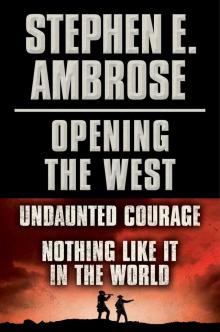 Undaunted Courage
Undaunted Courage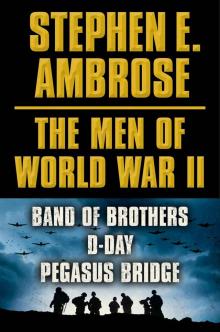 The Victors: Eisenhower and His Boys
The Victors: Eisenhower and His Boys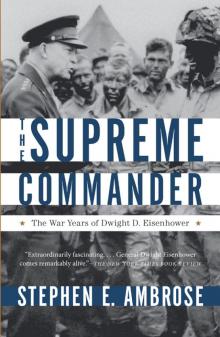 The Supreme Commander
The Supreme Commander Ike's Spies: Eisenhower and the Espionage Establishment
Ike's Spies: Eisenhower and the Espionage Establishment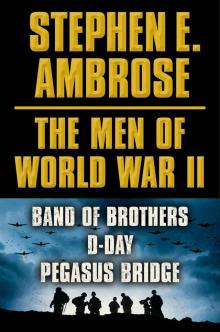 The Men of World War II
The Men of World War II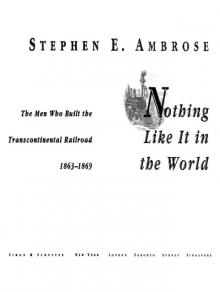 Nothing Like It in the World The Men Who Built the Transcontinental Railroad 1863-1869
Nothing Like It in the World The Men Who Built the Transcontinental Railroad 1863-1869 Ike's Spies
Ike's Spies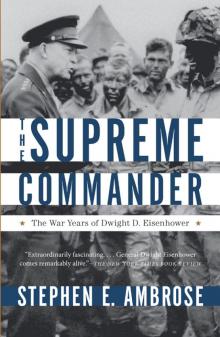 Supreme Commander
Supreme Commander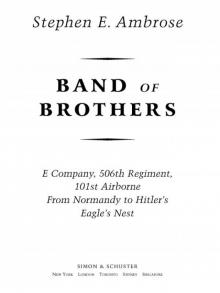 Band of Brothers
Band of Brothers